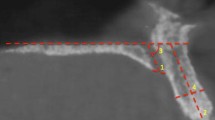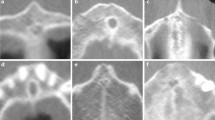Abstract
Purpose
For dental implant treatment planning and placement, a precise anatomic description of the nasopalatine canal (NC) is necessary. This descriptive retrospective study evaluated dimensions of the NC and buccal bone plate (BBP) and the tridimensional association of the anatomic variants of NC, using cone-beam computed tomography (CBCT).
Methods
This study included 230 CBCTs. Sagittal slices were used for measurements of the NC and BBP and to evaluate shape and direction-course of the NC. Coronal slices were used to assess NC shape and axial slices to assess number of incisive foramina and foramina of Stenson.
Results
Mean NC length was 12.34 ± 2.79 mm, statistically significant differences were detected between genders (p < 0.001). Mean BBP length was 20.87 ± 3.68 mm, statistically significant differences were found for the dental status (p < 0.001) and mean BBP width was 6.83 ± 1.28 mm, significant differences were detected between genders (p < 0.001). Mean nasopalatine angle was 73.33° ± 8.11°, significant differences were found in sagittal and coronal classifications. The most prevalent canal was: cylindrical sagittal shape (48.2 %); slanted-straight direction-course (57.6 %); Ya-type coronal shape (42.4 %); and one foramen incisive with two Stenson’s foramina (1–2) (50.9 %). Sagittal shape was associated with sagittal direction-course (p < 0.001). Coronal shape was associated with axial classification (p < 0.001).
Conclusions
The NC anatomy is highly variable. Gender is related to the NC length and BBP width, while dental status is related to BBP length. There was an association between the different sagittal classifications of the NC and between the coronal shape and axial classification.








Similar content being viewed by others
References
Araujo MG, Lindhe J (2005) Dimensional ridge alterations following tooth extraction. An experimental study in the dog. J Clin Periodontol 32:212–218
Artzi Z, Nemcovsky CE, Bitlitum I, Segal P (2000) Displacement of the incisive foramen in conjunction with implant placement in the anterior maxilla without jeopardizing vitality of nasopalatine nerve and vessels: a novel surgical approach. Clin Oral Implants Res 11:505–510
Atwood DA (1979) Bone loss of edentulous alveolar ridges. J Periodontol 50:11–21
Atwood DA (1962) Some clinical factors related to rate of resorption of residual ridges. J Prosthet Dent 12:441–450
Mercier P (1997) Resorption patterns of the residual ridge. In: Block MS, Kent JN, Guerra LR (eds) Implants in dentistry: essentials of endosseous implants for maxillofacial reconstruction. WB Saunders Company, Philadelphia, pp 10–16
Bornstein MM, Balsiger R, Sendi P, von Arx T (2011) Morphology of the nasopalatine canal and dental implant surgery: a radiographic analysis of 100 consecutive patients using limited cone-beam computed tomography. Clin Oral Implants Res 22:295–301
Buser D, Martin W, Belser UC (2004) Optimizing esthetics for implant restorations in the anterior maxilla: anatomic and surgical considerations. Int J Oral Maxillofac Implants 19(Suppl):43–61
Cawood JI, Howell RA (1988) A classification of the edentulous jaws. Int J Oral Maxillofac Surg 17:232–236
Cawood JI, Howell RA (1991) Reconstructive preprosthetic surgery. I. Anatomical considerations. Int J Oral Maxillofac Surg 20:75–82
de Oliveira-Santos C, Rubira-Bullen IR, Monteiro SA, Leon JE, Jacobs R (2013) Neurovascular anatomical variations in the anterior palate observed on CBCT images. Clin Oral Implants Res 24:1044–1048
Güncü GN, Yildirim YD, Yilmaz HG, Galindo-Moreno P, Velasco-Torres M, Al-Hezaimi K, Al-Shawaf R, Karabulut E, Wang HL, Tözüm TF (2013) Is there a gender difference in anatomic features of incisive canal and maxillary environmental bone? Clin Oral Implants Res 24:1023–1026
Liang X, Jacobs R, Martens W, Hu Y, Adriaensens P, Quirynen M, Lambrichts I (2009) Macro- and micro-anatomical, histological and computed tomography scan characterization of the nasopalatine canal. J Clin Periodontol 36:598–603
Mardinger O, Namani-Sadan N, Chaushu G, Schwartz-Arad D (2008) Morphologic changes of the nasopalatine canal related to dental implantation: a radiologic study in different degrees of absorbed maxillae. J Periodontol 79:1659–1662
Mraiwa N, Jacobs R, Van Cleynenbreugel J, Sanderink G, Schutyser F, Suetens P, van Steenberghe D, Quirynen M (2004) The nasopalatine canal revisited using 2D and 3D CT imaging. Dentomaxillofac Radiol 33:396–402
Neves FS, Oliveira LK, Ramos Mariz AC, Crusoe-Rebello I, de Oliveira-Santos C (2013) Rare anatomical variation related to the nasopalatine canal. Surg Radiol Anat 35:853–855
Peñarrocha M, Carrillo C, Uribe R, Garcia B (2009) The nasopalatine canal as an anatomic buttress for implant placement in the severely atrophic maxilla: a pilot study. Int J Oral Maxillofac Implants 24:936–942
Pietrokovski J, Starinsky R, Arensburg B, Kaffe I (2007) Morphologic characteristics of bony edentulous jaws. J Prosthodont 16:141–147
Radlanski RJ, Emmerich S, Renz H (2004) Prenatal morphogenesis of the human incisive canal. Anat Embryol 208:265–271
Rosenquist JB, Nystrom E (1992) Occlusion of the incisal canal with bone chips. A procedure to facilitate insertion of implants in the anterior maxilla. Int J Oral Maxillofac Surg 21:210–211
Scher EL (1994) Use of the incisive canal as a recipient site for root form implants: preliminary clinical reports. Implant Dent 3:38–41
Song WC, Jo DI, Lee JY, Kim JN, Hur MS, Hu KS, Kim HJ, Shin C, Koh KS (2009) Microanatomy of the incisive canal using three-dimensional reconstruction of microCT images: an ex vivo study. Oral Surg Oral Med Oral Pathol Oral Radiol Endod 108:583–590
Tözüm TF, Güncü GN, Yildirim YD, Yilmaz HG, Galindo-Moreno P, Velasco-Torres M, Al-Hezaimi K, Al-Sadhan R, Karabulut E, Wang HL (2012) Evaluation of maxillary incisive canal characteristics related to dental implant treatment with computerized tomography: a clinical multicenter study. J Periodontol 83:337–343
Trombelli L, Farina R, Marzola A, Bozzi L, Liljenberg B, Lindhe J (2008) Modeling and remodeling of human extraction sockets. J Clin Periodontol 35:630–639
Valcu M, Rusu MC, Sendroiu VM, Didilescu AC (2011) The lateral incisive canals of the adult hard palate - aberrant anatomy of a minor form of clefting? Rom J Morphol Embryol 52:947–949
Van der Weijden F, Dell’Acqua F, Slot DE (2009) Alveolar bone dimensional changes of post-extraction sockets in humans: a systematic review. J Clin Periodontol 36:1048–1058
von Arx T, Lozanoff S, Sendi P, Bornstein MM (2013) Assessment of bone channels other than the nasopalatine canal in the anterior maxilla using limited cone beam computed tomography. Surg Radiol Anat 35:783–790
Williams PL, Warwick R, Dyson M, Bannister LH (1985) Gray’s Anatomy. Salvat, Barcelona
Acknowledgments
The authors express their gratitude to the radiologist Lilian Sampedro Crujeiras, for her exceptional work in the Radiology Unit. For the statistical analysis, we greatly appreciate the work done by Sara Marsillas Rascado from the Department of Basic, Social Psychology and Methodology at the Psychology School.
Conflict of interest
The authors declare that they have no conflict of interest.
Ethical standards
This study complies with the current laws of Galicia (Spain) and it was approved by the Galician Ethics Committee of Clinical Research (Ref: 2012/272). Written informed consent was obtained from all patients to participate in the study.
Author information
Authors and Affiliations
Corresponding author
Rights and permissions
About this article
Cite this article
Fernández-Alonso, A., Suárez-Quintanilla, J.A., Muinelo-Lorenzo, J. et al. Three-dimensional study of nasopalatine canal morphology: a descriptive retrospective analysis using cone-beam computed tomography. Surg Radiol Anat 36, 895–905 (2014). https://doi.org/10.1007/s00276-014-1297-3
Received:
Accepted:
Published:
Issue Date:
DOI: https://doi.org/10.1007/s00276-014-1297-3




